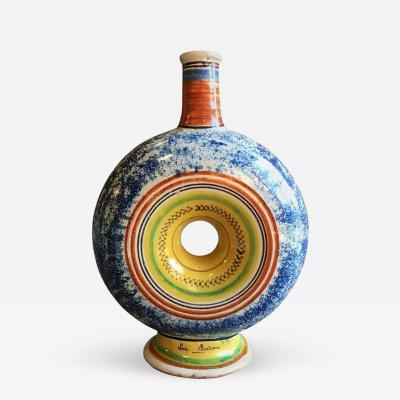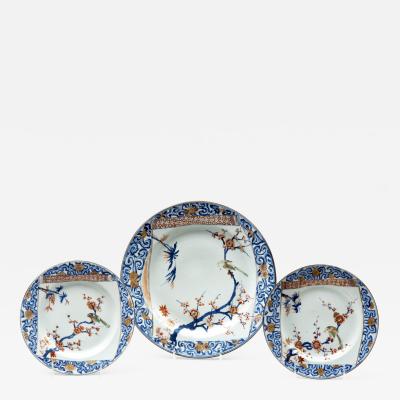Kangxi Porcelain
In 1915, John D. Rockefeller, Jr., wrote a letter to his father requesting a loan of over $1 million to buy Chinese porcelain. In an attempt to prove his sincere interest in the material, the young Rockefeller wrote, “I have never squandered money on horses, yachts, automobiles, or other foolish extravagances. A fondness for these porcelains is my only hobby…. I have found their study a great recreation and diversion, and I have become very fond of them…. The money put into these porcelains is not lost or squandered.”1
Our New England collector shares the enthusiasm that Rockefeller, Jr., experienced in his quest to buy Chinese porcelain. A long-time collector of English and American furniture, he noticed a pair of Kangxi (1662–1722) blue-and-white vases on a visit to an antiques shop fifteen years ago. Although familiar with China Trade “Canton” porcelain of the early nineteenth century, he was astounded by the differences between the two types of wares. “The color on the Kangxi vases was jewel-like,” he recalls. On a subsequent visit to an antiques show, he ventured into some booths that featured Kangxi porcelain and did not leave empty-handed—his Kangxi collecting had begun.
The Western tradition of collecting Chinese porcelain dates to the early seventeenth century, when the Netherlands and Portugal dominated the China trade. In the late seventeenth century, Queen Mary (1662–1694) filled one of her palaces with Chinese porcelain made during the reign of the Emperor Kangxi (1662–1722). Her passions in this regard inspired a craze for collecting among the English aristocracy. For instance, in the halls of Blenheim Palace, home of the Dukes of Marlborough and birthplace of Winston Churchill, are prominent displays of Kangxi porcelain acquired in the early eighteenth century. Augustus the Strong, Elector of Saxony and King of Poland, formed another of the world’s great collections. Such was his passion for the imported wares that he traded a regiment of Dragoons with another king for a group of Kangxi vases. The vases are still in existence, and they, as well as others of similar form, are now referred to as “soldier vases.” The royalty and aristocracy in France, the Netherlands, Sweden, and Portugal also formed great collections.
The popularity of collecting Kangxi Chinese porcelain was revived in the late nineteenth century, with the painter James McNeill Whistler (1834-1903) among the notable collectors. The famous Peacock Room designed for a London townhouse by Whistler and removed to the Smithsonian in Washington, D.C., displays part of Whistler’s collection of Kangxi blue-and-white. By the turn of the twentieth century, great collections of Kangxi blue-and-white and famille verte (green family) porcelain had been amassed on both sides of the Atlantic. In America, tycoons John Pierpont Morgan, Henry Clay Frick, and John D. Rockefeller, Jr., as noted earlier, formed great collections, portions of which have been on public display. Over 1,000 pieces from the Morgan collection, for example, were exhibited at the Metropolitan Museum of Art in New York in 1904 (many of the pieces were subsequently purchased by Rockefeller, Jr., in 1915). And Frick’s Chinese porcelain can now be seen at The Frick Collection in New York.
In appreciation of some of the noteworthy American and English collections of Chinese porcelain formed at the turn of the twentieth century, our collector has amassed pieces of Kangxi from the Eumorfopoulos, Ionides, Dreesman, Duke Buccleuch, Garland, and Morgan collections, as well as pieces once owned by Louis XV and Augustus the Strong. Part of his interest in owning objects that were once in great collections is the level of quality and the provenance associated with each piece. “Everything I own has a story, be it the tale related through the images, history of ownership, or how I found an object,” he notes. “However, it takes more than a story for me to buy an object. I am initially drawn to the beauty and quality of the object itself.” When queried whether he regards his porcelain as decorative or fine art, he quickly answers, “Many of the pieces are definitely in the fine art category. A few I would even regard as true masterpieces.”
When asked what attracts our collector to porcelain of the Kangxi period in particular, he notes that the reign of Emperor Kangxi was “a true golden age, where the old traditions combined with improved technical skill and freedom of expression. The painting is very bold and freely done with amazing control and detail. There is humor, insight, a real understanding of nature that rings true. In many ways it is analogous to seventeenth-century Dutch and Flemish art, which I also collect because of the similarities in expression.”
“The Kangxi period was also a great age of export,” our collector adds. “Yet the designs were still executed in the Chinese taste, not yet conforming to Western taste as they later did. The level of quality maintained in the manufacture and decoration of these wares was outstanding.” He further notes that in this period it is often a challenge to determine whether an object was made for export or domestic use: “Even if a form was inspired by an English object, the decoration was often purely Chinese.”
Offering insight for the beginner, our collector provides the following suggestions. 1) Build a strong collection in one area, such as Kangxi, rather than trying to buy a little bit of everything. 2) When starting to collect, don’t adhere to the old saying, “trust your judgment and buy what you like.” This approach could be hazardous when collecting Chinese porcelain. The best thing a beginner can do is to work with the top dealers in the field and learn from them. Dealers represented in this collection, for example, include Berwald Oriental Art, Ralph M. Chait Galleries, Cohen & Cohen, and S. Marchant & Son. A collector really needs a trained eye when buying in this field, and that is only gained through experience. 3) Buy from dealers who specialize in Chinese ceramics. They know the market and often have more realistic pricing than the generalists. Also, be cautious of auctions. Many fakes are sold to the unwary. 4) Don’t limit yourself to buying only the best if that means buying only one or two great items. There is joy in quantity, and you need quantity to learn; you can always upgrade as your collection grows. “Some of my favorite pieces were my least expensive purchases,” says our collector. “For me, there is only a loose correlation between money and the pleasure a piece brings.” 5) Too much emphasis is put on perfection. A minor chip does not necessarily diminish the beauty of an object. The rarer and more beautiful an object, the more willing a collector should be to accept a little damage.
Looking to the future of the Chinese porcelain market and how he has seen it evolve, our collector notes, “The most recent trend is that the mainland Chinese are aggressively buying back Chinese porcelains from the West.” He also notes that the amount of money quality objects are bringing is increasing. “The Qing (1644–1911) Imperial pieces have skyrocketed in price, with quality Ming (1368–1644) and Qing domestic and export objects also increasing in value as less and less are available for purchase. Chinese porcelain is a world market, and that market is deepening. Some of the best private collections are in America, England, France, Portugal, Germany, Brazil, and the Netherlands, as well as Hong Kong and Taiwan. Who knows what collections will emerge on the mainland?”
Continuing to build on his passion, our collector recently purchased a large Daoist subject famille verte vase (Fig. 2) purportedly made for the emperor’s summer palace. When asked about his favorite purchase, he responds, “You mean which of my children do I like best?” Upon being prodded, he offered that among his favorite objects are the vase in Figure 2 and the monteith. Always on the lookout, he includes in his wish list a set of Kangxi “month cups,” each depicting a month of the year; a “birthday dish,” celebrating the important 60th birthday of Emperor Kangxi; a beaker vase with egret and lotus-blossom design—and anything else that catches his eye. “Let’s face it,” he says, “when you are a collector, there is never an end to your list.”















.jpg)
.jpg)
.jpg)
.jpg)
.jpg)
.jpg)
.jpg)
.jpg)
















